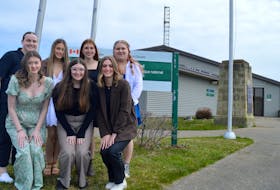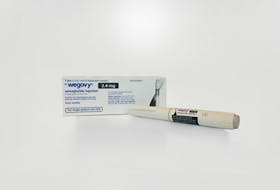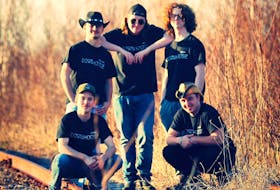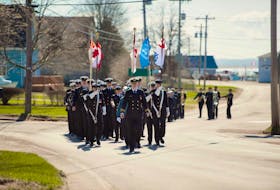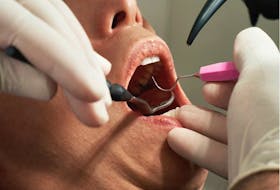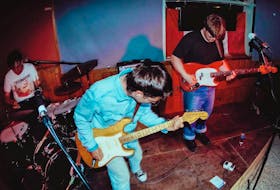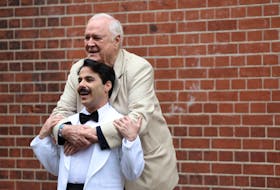Calvin (The Sea Urchin Man) Flanders is a fixture. Every day he can be found at the Galion lookout on the east side of the island paradise of St. Martin knee deep in the crystal clear water of the Caribbean Sea.
In keeping with his nickname, he’s a master at spotting and extracting black and white spiky sea urchins from the Caribbean.
“Pick ’em up gently,” Flanders says with a wide smile.
“Those spikes are sharp, you know.”
He’ll stray from his nickname and also pluck sand dollars, starfish and the beautifully curved-shelled conch from the sandy turquoise shallows.
He’s made a business of what he calls “sealife pickin’” by showing the creatures to tourists and offering them up for the foreigners to hold and get their picture taken.
“Here, just let me place this in your palm so you don’t get stabbed,” Flanders says as he hands over a black sea urchin for my photo op.
To balance things out, I hold an orange-tinged starfish in the other hand and mug for the camera.
I hand the spiky ball and five-pointer back and Saunders does his own best poses for the camera.
He turns to an older American couple and asks them if they want to handle the critters and have their photos taken.
“Um, definitely not,” says the woman.
“But I’ll take take your picture.”
She does and Flanders then tosses the sea urchin and starfish back in the water nearby — handy for grabbing for the next wave of tourists.
As we wave our goodbyes we each drop a couple of euros in the plastic container Flanders has set out on a little table on the beach along with an assortment of shells.
There’s no pressure to leave any money, but everyone seems to.
After all, we’re in St. Martin, in holiday mode. Standing ankle deep in the warm sea handling exotic sea creatures is worth it.
The currency of choice in Flander’s tip container is euros because St. Martin is a little piece of France plunked down in the Caribbean.
(Not to be confused with St. Maarten, the other side of this tiny West Indies island which is Dutch. There, Netherland Antilles guilders are the official currency).
In keeping with the France-Caribbean connection, St. Martin is franco-sophisticated with a well-earned beach culture.
Our tour group experiences both by dining on island gourmet dishes and sipping French wines under both beach palapas and in fine restaurants.
We stay at a hotel with European high style; make our own scents at a perfumery; take a landscape painting class; drop in on a Mardi Gras-style street party; frequent numerous beach bars; take a scuba lesson; snorkel; loll on the beach; and hang out poolside.
Tijon’s Parfumerie has been ranked by TripAdvisor.com as the No. 1 non-water activity in St. Martin for its unique opportunities to create your own fragrance.
An hour in the lab spent smelling and mixing the essential and fragrance oils you like results in a personal scent in a 55 ml bottle you get to take home for 69 euros (about $88).
I created St. Stephen cologne — a label derived by mashing my first name with St. Martin.
It’s billed as a fresh masculine scent with some citrus pinned down by a bit of musk.
Artist and St. Martin treasure Miss Ruby Bute has taught painting to school kids, prisoners and now tourists.
Drop by her Silk Cotton Grove Art Gallery and she will lead you out to the gazebo for a two-hour art class that involves as much storytelling and sass and breaks for coconut pie and rose wine as it does for actual painting.
My resulting canvas is a primitive landscape of crooked gateposts and too-high hills.
But I leave with praise in my ears from Miss Ruby and a sense of accomplishment.
There were also the more traditional island pursuits of introductory scuba with Aquatic Adventure Diving at Crowl Rock and eco-snorkelling at small offshore Pinel Island in the St. Martin National Reserve.
Intro scuba is all about getting comfortable breathing compressed air a few feet underwater and then going on a short dive with an instructor by your side to see angel fish, sturgeons and even a menacing-looking baracuda.
Eco-snorkelling features a new satellite technology that transmits audio to an oversized snorkel mouthpiece so sound is transmitted by reverberation through your jaw and inner ear so you hear commentary and music.
Besides being blown away by the gadgetry, a school of blue tangs that moved like an indigo silk sheet snapping in the wind was the highlight.
Calvin (The Sea Urchin Man) Flanders is a fixture. Every day he can be found at the Galion lookout on the east side of the island paradise of St. Martin knee deep in the crystal clear water of the Caribbean Sea.
In keeping with his nickname, he’s a master at spotting and extracting black and white spiky sea urchins from the Caribbean.
“Pick ’em up gently,” Flanders says with a wide smile.
“Those spikes are sharp, you know.”
He’ll stray from his nickname and also pluck sand dollars, starfish and the beautifully curved-shelled conch from the sandy turquoise shallows.
He’s made a business of what he calls “sealife pickin’” by showing the creatures to tourists and offering them up for the foreigners to hold and get their picture taken.
“Here, just let me place this in your palm so you don’t get stabbed,” Flanders says as he hands over a black sea urchin for my photo op.
To balance things out, I hold an orange-tinged starfish in the other hand and mug for the camera.
I hand the spiky ball and five-pointer back and Saunders does his own best poses for the camera.
He turns to an older American couple and asks them if they want to handle the critters and have their photos taken.
“Um, definitely not,” says the woman.
“But I’ll take take your picture.”
She does and Flanders then tosses the sea urchin and starfish back in the water nearby — handy for grabbing for the next wave of tourists.
As we wave our goodbyes we each drop a couple of euros in the plastic container Flanders has set out on a little table on the beach along with an assortment of shells.
There’s no pressure to leave any money, but everyone seems to.
After all, we’re in St. Martin, in holiday mode. Standing ankle deep in the warm sea handling exotic sea creatures is worth it.
The currency of choice in Flander’s tip container is euros because St. Martin is a little piece of France plunked down in the Caribbean.
(Not to be confused with St. Maarten, the other side of this tiny West Indies island which is Dutch. There, Netherland Antilles guilders are the official currency).
In keeping with the France-Caribbean connection, St. Martin is franco-sophisticated with a well-earned beach culture.
Our tour group experiences both by dining on island gourmet dishes and sipping French wines under both beach palapas and in fine restaurants.
We stay at a hotel with European high style; make our own scents at a perfumery; take a landscape painting class; drop in on a Mardi Gras-style street party; frequent numerous beach bars; take a scuba lesson; snorkel; loll on the beach; and hang out poolside.
Tijon’s Parfumerie has been ranked by TripAdvisor.com as the No. 1 non-water activity in St. Martin for its unique opportunities to create your own fragrance.
An hour in the lab spent smelling and mixing the essential and fragrance oils you like results in a personal scent in a 55 ml bottle you get to take home for 69 euros (about $88).
I created St. Stephen cologne — a label derived by mashing my first name with St. Martin.
It’s billed as a fresh masculine scent with some citrus pinned down by a bit of musk.
Artist and St. Martin treasure Miss Ruby Bute has taught painting to school kids, prisoners and now tourists.
Drop by her Silk Cotton Grove Art Gallery and she will lead you out to the gazebo for a two-hour art class that involves as much storytelling and sass and breaks for coconut pie and rose wine as it does for actual painting.
My resulting canvas is a primitive landscape of crooked gateposts and too-high hills.
But I leave with praise in my ears from Miss Ruby and a sense of accomplishment.
There were also the more traditional island pursuits of introductory scuba with Aquatic Adventure Diving at Crowl Rock and eco-snorkelling at small offshore Pinel Island in the St. Martin National Reserve.
Intro scuba is all about getting comfortable breathing compressed air a few feet underwater and then going on a short dive with an instructor by your side to see angel fish, sturgeons and even a menacing-looking baracuda.
Eco-snorkelling features a new satellite technology that transmits audio to an oversized snorkel mouthpiece so sound is transmitted by reverberation through your jaw and inner ear so you hear commentary and music.
Besides being blown away by the gadgetry, a school of blue tangs that moved like an indigo silk sheet snapping in the wind was the highlight.


